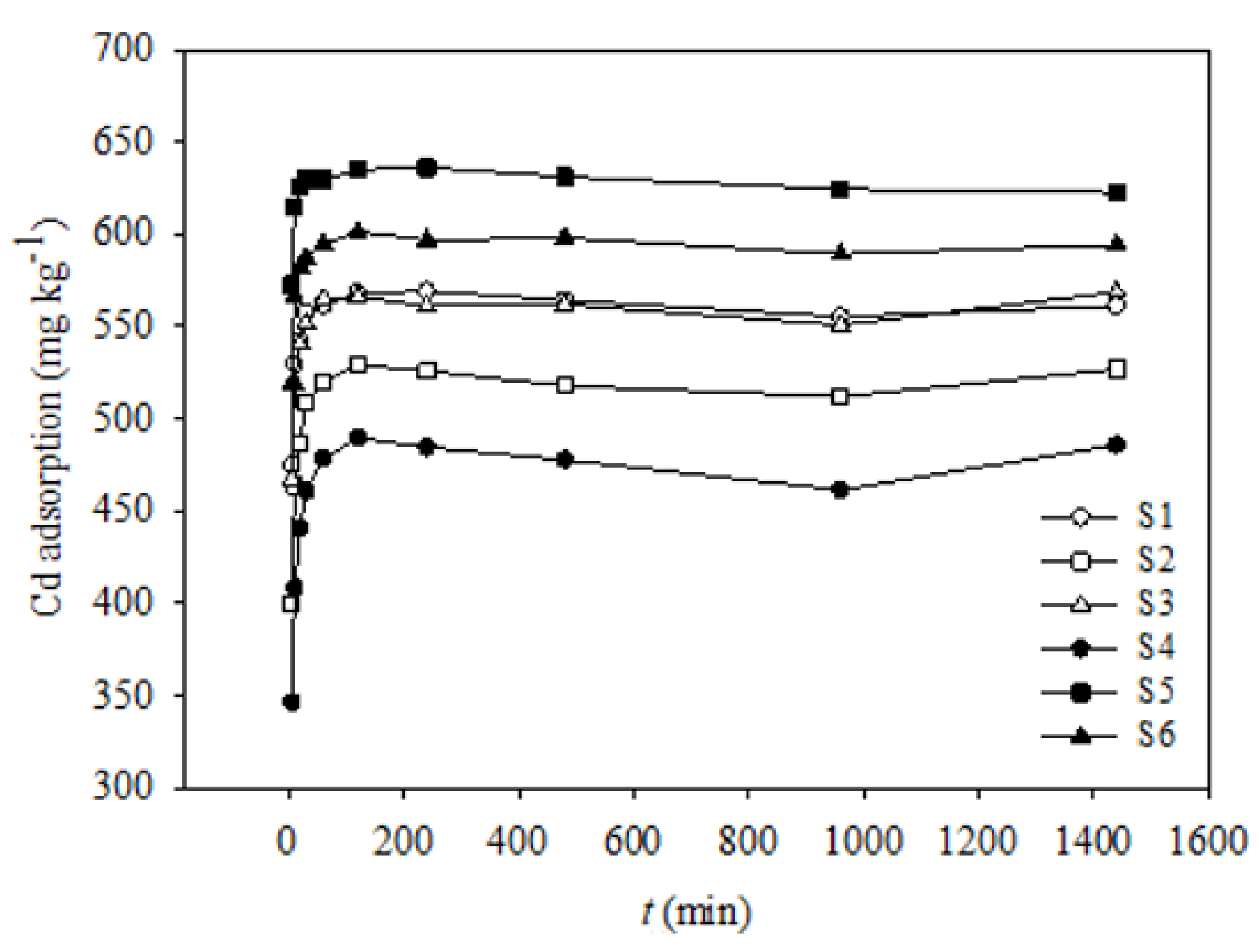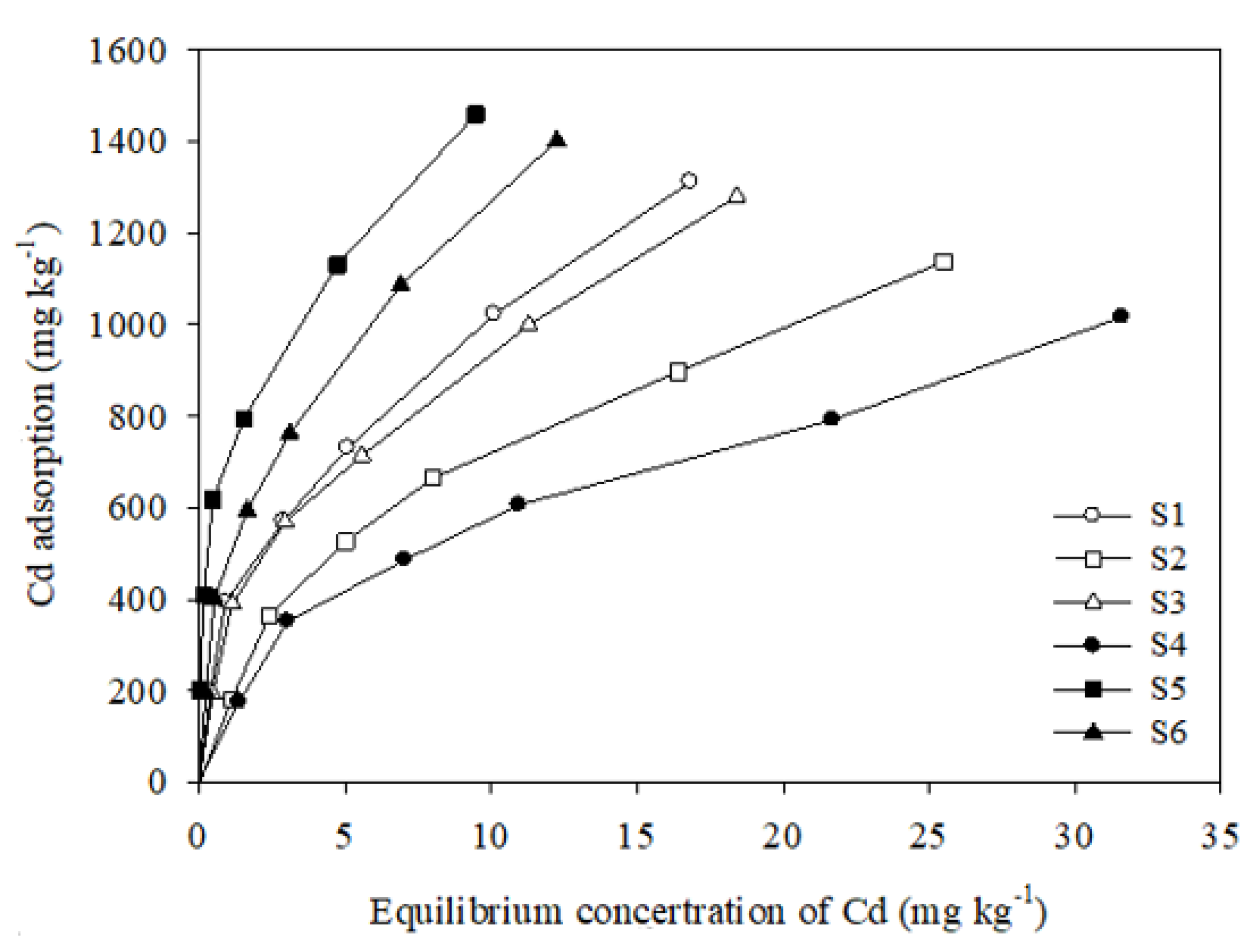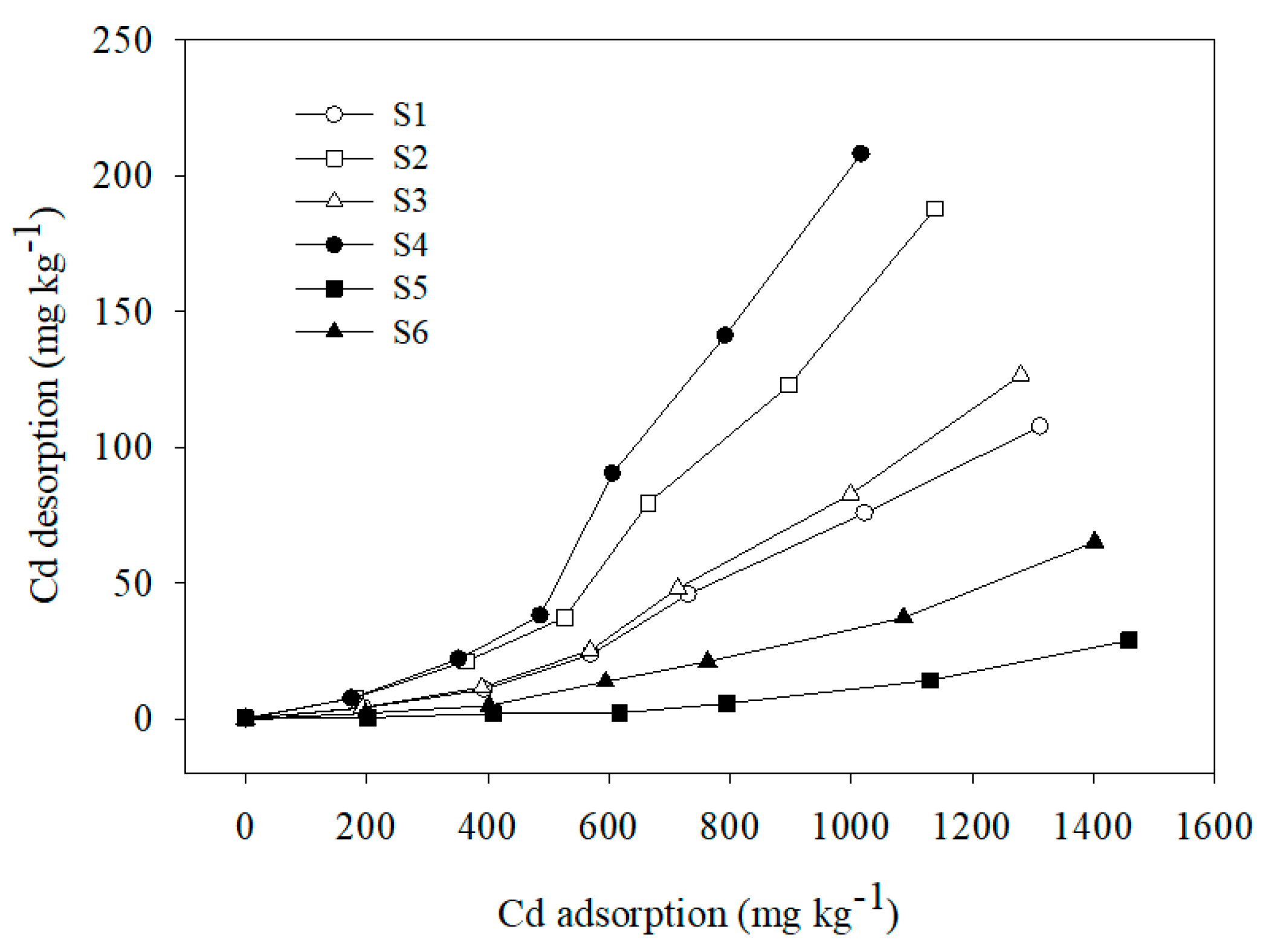Adsorption and Desorption Characteristics of Cadmium on Different Contaminated Paddy Soil Types: Kinetics, Isotherms, and the Effects of Soil Properties
Abstract
:1. Introduction
2. Materials and Methods
2.1. Soil Samples
2.2. Kinetics Adsorption Experiments
2.3. Adsorption Kinetics Models
2.4. Isothermal Adsorption–Desorption Experiments
2.4.1. Adsorption Isotherm Experiments
2.4.2. Adsorption Isotherm Models
2.4.3. Desorption
2.5. Statistical Analysis
3. Results and Discussion
3.1. Adsorption Kinetics
3.2. Kinetic Equations for Cd(II) Adsorption
3.3. Adsorption Isotherms
3.4. Isotherm Equations for Cd(II) Adsorption
3.5. Desorption Isotherms
4. Conclusions
Author Contributions
Funding
Institutional Review Board Statement
Informed Consent Statement
Conflicts of Interest
References
- Unuabonah, E.; Adebowale, K.; Olu-Owolabi, B.; Yang, L.; Kong, L. Adsorption of Pb (II) and Cd (II) from aqueous solutions onto sodium tetraborate-modified Kaolinite clay: Equilibrium and thermodynamic studies. Hydrometallurgy 2008, 93, 1–9. [Google Scholar] [CrossRef]
- Fei, W.; Wang, L.J.; Li, J.S.; Sun, X.Y.; Han, W.Q. Adsorption behavior and mechanism of cadmium on strong-acid cation exchange resin. Trans. Nonferrous Met. Soc. China 2009, 19, 740–744. [Google Scholar]
- Khan, M.A.; Khan, S.; Khan, A.; Alam, M. Soil contamination with cadmium, consequences and remediation using organic amendments. Sci. Total Environ. 2017, 601–602, 1591–1605. [Google Scholar] [CrossRef]
- Li, P.; Wang, X.; Allinson, G.; Li, X.; Xiong, X. Risk assessment of heavy metals in soil previously irrigated with industrial wastewater in Shenyang, China. J. Hazard. Mater. 2009, 161, 516–521. [Google Scholar] [CrossRef] [PubMed]
- Ma, L.; Xu, R.; Jiang, J. Adsorption and desorption of Cu(II) and Pb(II) in paddy soils cultivated for various years in the subtropical China. J. Environ. Sci. 2010, 22, 689–695. [Google Scholar] [CrossRef]
- Lee, C.S.L.; Li, X.; Shi, W.; Cheung, S.C.N.; Thornton, I. Metal contamination in urban, suburban, and country park soils of Hong Kong: A study based on GIS and multivariate statistics. Sci. Total Environ. 2006, 356, 45–61. [Google Scholar] [CrossRef] [PubMed] [Green Version]
- Li, Z.; Ma, Z.; van der Kuijp, T.J.; Yuan, Z.; Huang, L. A review of soil heavy metal pollution from mines in China: Pollution and health risk assessment. Sci. Total Environ. 2014, 468–469, 843–853. [Google Scholar] [CrossRef]
- Luo, X.L.; Guo, Q.R.; Xie, Z.Y.; Yang, J.J.; Chai, Z.W.; Liu, X.; Wu, S.F. Study on heavy metal pollution in typical rural soils in Pearl River Delta area. Ecol. Environ. Sci. 2014, 23, 485–489. [Google Scholar]
- Mohapatra, M.; Anand, S. Studies on sorption of Cd(II) on Tata chromite mine overburden. J. Hazard. Mater. 2007, 148, 553–559. [Google Scholar] [CrossRef]
- Xinxin, Y.; Yibing, M.; Bo, S. Influence of soil type and genotype on Cd bioavailability and uptake by rice and implications for food safety. J. Environ. Sci. 2012, 24, 1647–1654. [Google Scholar]
- Wu, S.; Zhang, K.; Wang, X.; Jia, Y.; Sun, B.; Luo, T.; Meng, F.; Jin, Z.; Lin, D.; Shen, W.; et al. Enhanced adsorption of cadmium ions by 3D sulfonated reduced graphene oxide. Chem. Eng. J. 2015, 262, 1292–1302. [Google Scholar] [CrossRef]
- Huang, F.; Gao, L.-Y.; Deng, J.-H.; Chen, S.-H.; Cai, K.-Z. Quantitative contribution of Cd 2+ adsorption mechanisms by chicken-manure-derived biochars. Environ. Sci. Pollut. Res. 2018, 25, 28322–28334. [Google Scholar] [CrossRef]
- Zhao, Z.; Nie, T.; Yang, Z.; Zhou, W. The role of soil components in the sorption of tetracycline and heavy metals in soils. RSC Adv. 2018, 8, 32178–32187. [Google Scholar] [CrossRef] [Green Version]
- Srivastava, P.; Singh, B.; Angove, M. Competitive adsorption behavior of heavy metals on kaolinite. J. Colloid Interface Sci. 2005, 290, 28–38. [Google Scholar] [CrossRef] [PubMed]
- Mustafa, G.; Kookana, R.S.; Singh, B. Desorption of cadmium from goethite: Effects of pH, temperature and aging. Chemosphere 2006, 64, 856–865. [Google Scholar] [CrossRef]
- Gerritse, R.G.; Van Driel, W. The Relationship Between Adsorption of Trace Metals, Organic Matter, and pH in Temperate Soils. J. Environ. Qual. 1984, 13, 197–204. [Google Scholar] [CrossRef]
- Glover, L.J., II; Eick, M.J.; Brady, P.V. Desorption Kinetics of Cadmium2 and Lead2 from Goethite: Influence of Time and Organic Acids. Soil Sci. Soc. Am. J. 2002, 66, 797–804. [Google Scholar] [CrossRef]
- Shirvani, M.; Shariatmadari, H.; Kalbasi, M. Kinetics of cadmium desorption from fibrous silicate clay minerals: Influence of organic ligands and aging. Appl. Clay Sci. 2007, 37, 175–184. [Google Scholar] [CrossRef]
- Elliott, H.A.; Liberati, M.R.; Huang, C.P. Effect of iron oxide removal on heavy metal sorption by acid subsoils. Water Air Soil Pollut. 1986, 27, 379–389. [Google Scholar] [CrossRef]
- Singh, B.; Alloway, B.J.; Bochereau, F.J.M. Cadmium sorption behavior of natural and synthetic zeolites. Commun. Soil Sci. Plant Anal. 2000, 31, 2775–2786. [Google Scholar] [CrossRef]
- Jobstmann, H.; Singh, B. Cadmium Sorption by Hydroxy-Aluminium Interlayered Montmorillonite. Water Air Soil Pollut. 2001, 131, 203–215. [Google Scholar] [CrossRef]
- Spark, K.; Wells, J.; Johnson, B. Characterizing trace metal adsorption on kaolinite. Eur. J. Soil Sci. 1995, 46, 633–640. [Google Scholar] [CrossRef]
- Alaboudi, K.A.; Ahmed, B.; Brodie, G. Phytoremediation of Pb and Cd contaminated soils by using sunflower (Helianthus annuus) plant. Ann. Agric. Sci. 2018, 63, 123–127. [Google Scholar] [CrossRef]
- Wang, J.; Lv, J.; Fu, Y. Effects of organic acids on Cd adsorption and desorption by two anthropic soils. Front. Environ. Sci. Eng. 2012, 7, 19–30. [Google Scholar] [CrossRef]
- Pardo, M. Sorption of lead, copper, zinc, and cadmium by soils: Effect of nitriloacetic acid on metal retention. Commun. Soil Sci. Plant. Anal. 2000, 31, 31–40. [Google Scholar] [CrossRef]
- Sparks, D.L. Environmental Soil Chemistry, 2nd ed.; Elsevier: Amsterdam, The Netherlands, 2003. [Google Scholar]
- Wang, Y.; Tang, X.; Chen, Y.; Zhan, L.; Li, Z.; Tang, Q. Adsorption behavior and mechanism of Cd(II) on loess soil from China. J. Hazard. Mater. 2009, 172, 30–37. [Google Scholar] [CrossRef] [PubMed]
- Tran, Y.; Barry, D.; Bajracharya, K. Cadmium desorption in sand. Environ. Int. 2002, 28, 493–502. [Google Scholar] [CrossRef]
- Zhang, D.L.; Jin, M.G.; Fang, Y.; Zhou, X.; Mei, Y.U. Effect of different acidic conditions on the adsorption-desorption characteristics of Cd~(2+) in a silt loam. Soil Fertil. Sci. China 2014, 04, 29–34. [Google Scholar]
- Lu, R.K. Methods for Soil Agrochemistry Analysis; China Agricultural Science and Technology Press: Beijing, China, 2000. [Google Scholar]
- Klute, A. Physical and mineralogical methods; American Society of Agronomy: Madison, WI, USA, 1986. [Google Scholar]
- Pansu, M.; Gautheyrou, J. Handbook of Soil Analysis; Springer: Berlin/Heidelberg, Germany, 2006. [Google Scholar]
- Amacher, M.; Spark, D. Nickel, cadmium and lead. Methods Soil Anal. Part. Chem. Methods 1996, 5, 739–768. [Google Scholar]
- Nordberg, G.F.; Fowler, B.A.; Nordberg, M. (Eds.) Handbook on the Toxicology of Metals; Elsevier B.V.: Amestardam, The Netherlands, 2015. [Google Scholar]
- Fan, H.-T.; Sun, Y.; Tang, Q.; Li, W.-L.; Sun, T. Selective adsorption of antimony(III) from aqueous solution by ion-imprinted organic–inorganic hybrid sorbent: Kinetics, isotherms and thermodynamics. J. Taiwan Inst. Chem. Eng. 2014, 45, 2640–2648. [Google Scholar] [CrossRef]
- Zhou, Y.; Liu, X.; Xiang, Y.; Wang, P.; Zhang, J.; Zhang, F.; Wei, J.; Luo, L.; Lei, M.; Tang, L. Modification of biochar derived from sawdust and its application in removal of tetracycline and copper from aqueous solution: Adsorption mechanism and modelling. Bioresour. Technol. 2017, 245, 266–273. [Google Scholar] [CrossRef]
- Foo, K.Y.; Hameed, B.H. Insights into the modeling of adsorption isotherm systems. Chem. Eng. J. 2010, 156, 2–10. [Google Scholar] [CrossRef]
- Huang, B.; Li, Z.; Huang, J.; Guo, L.; Nie, X.; Wang, Y.; Zhang, Y.; Zeng, G. Adsorption characteristics of Cu and Zn onto various size fractions of aggregates from red paddy soil. J. Hazard. Mater. 2014, 264, 176–183. [Google Scholar] [CrossRef]
- Ahmed, I.; Helal, A.A.; El Aziz, N.A.; Gamal, R.; Shaker, N.O. Influence of some organic ligands on the adsorption of lead by agricultural soil. Arab. J. Chem. 2019, 12, 2540–2547. [Google Scholar] [CrossRef] [Green Version]
- Gao, R.; Xiang, L.; Hu, H.; Fu, Q.; Zhu, J.; Liu, Y.; Huang, G. High-efficiency removal capacities and quantitative sorption mechanisms of Pb by oxidized rape straw biochars. Sci. Total Environ. 2020, 699, 134262. [Google Scholar] [CrossRef]
- Gupta, S.S.; Bhattacharyya, K.G. Kinetics of adsorption of metal ions on inorganic materials: A review. Adv. Colloid Interface Sci. 2011, 162, 39–58. [Google Scholar] [CrossRef]
- Zhu, L.; Tong, L.; Zhao, N.; Wang, X.; Yang, X.; Lv, Y. Key factors and microscopic mechanisms controlling adsorption of cadmium by surface oxidized and aminated biochars. J. Hazard. Mater. 2020, 382, 121002. [Google Scholar] [CrossRef]
- Rashti, M.R.; Esfandbod, M.; Adhami, E.; Srivastava, P. Cadmium desorption behaviour in selected sub-tropical soils: Effects of soil properties. J. Geochem. Explor. 2014, 144, 230–236. [Google Scholar] [CrossRef]
- Komy, Z.R.; Shaker, A.M.; Heggy, S.E.; El-Sayed, M.E. Kinetic study for copper adsorption onto soil minerals in the absence and presence of humic acid. Chemosphere 2014, 99, 117–124. [Google Scholar] [CrossRef] [PubMed]
- Guo, Y.; Tang, W.; Wu, J.; Huang, Z.; Dai, J. Mechanism of Cu(Ⅱ) adsorption inhibition on biochar by its aging process. J. Environ. Sci. 2014, 26, 2123–2130. [Google Scholar] [CrossRef] [PubMed]
- Naidu, R.; Kookana, R.S.; Sumner, M.E.; Harter, R.D.; Tiller, K.G. Cadmium Sorption and Transport in Variable Charge Soils: A Review. J. Environ. Qual. 1997, 26, 602–617. [Google Scholar] [CrossRef]
- Choi, Y.-K.; Choi, T.-R.; Gurav, R.; Bhatia, S.K.; Park, Y.-L.; Kim, H.J.; Kan, E.; Yang, Y.-H. Adsorption behavior of tetracycline onto Spirulina sp. (microalgae)-derived biochars produced at different temperatures. Sci. Total Environ. 2020, 710, 136282. [Google Scholar] [CrossRef]
- Feng, Q.; Zhang, Z.; Chen, Y.; Liu, L.; Zhang, Z.; Chen, C. Adsorption and Desorption Characteristics of Arsenic on Soils: Kinetics, Equilibrium, and Effect of Fe(OH)3 Colloid, H2SiO3 Colloid and Phosphate. Procedia Environ. Sci. 2013, 18, 602–617. [Google Scholar] [CrossRef] [Green Version]
- Zhou, J.; Ma, F.; Guo, H. Adsorption behavior of tetracycline from aqueous solution on ferroferric oxide nanoparticles assisted powdered activated carbon. Chem. Eng. J. 2020, 384, 123290. [Google Scholar] [CrossRef]
- Zhao, X.; Jiang, T.; Du, B. Effect of organic matter and calcium carbonate on behaviors of cadmium adsorption–desorption on/from purple paddy soils. Chemosphere 2014, 99, 41–48. [Google Scholar] [CrossRef] [PubMed]
- Borggaard, O.K.; Holm, P.E.; Strobel, B.W. Potential of dissolved organic matter (DOM) to extract As, Cd, Co, Cr, Cu, Ni, Pb and Zn from polluted soils: A review. Geoderma 2019, 343, 235–246. [Google Scholar] [CrossRef]
- Xu, R.; Xiao, S.; Zhao, A.; Ji, G. Effect of Cr(VI) anions on adsorption and desorption behavior of Cu(II) in the colloidal systems of two authentic variable charge soils. J. Colloid Interface Sci. 2005, 284, 22–29. [Google Scholar] [CrossRef]
- Khan, M.A.; Khan, S.; Ding, X.; Khan, A.; Alam, M. The effects of biochar and rice husk on adsorption and desorption of cadmium on to soils with different water conditions (upland and saturated). Chemosphere 2018, 193, 1120–1126. [Google Scholar] [CrossRef] [PubMed]
- Guo, X.; Zhang, S.; Shan, X.-Q.; Luo, E.I.L.; Pei, Z.; Zhu, Y.-G.; Liu, T.; Xie, Y.-N.; Gault, A. Characterization of Pb, Cu, and Cd adsorption on particulate organic matter in soil. Environ. Toxicol. Chem. 2006, 25, 2366–2373. [Google Scholar] [CrossRef]




| Soil Sampling Sites | pH | SOM a (g/kg) | CEC (cmol/kg) | Clay Ratio <0.002 mm (%) | FeDCB (g/kg) | FeAAO (g/kg) | MnDCB (mg/kg) | MnAAO (mg/kg) | T-Cd (mg/kg) |
|---|---|---|---|---|---|---|---|---|---|
| S1 | 5.53 | 38.06 | 7.47 | 17.88 | 13.84 | 3.69 | 58.68 | 51.48 | 2.61 |
| S2 | 5.13 | 35.17 | 8.06 | 19.01 | 16.54 | 4.19 | 18.31 | 11.14 | 13.08 |
| S3 | 5.28 | 37.82 | 8.89 | 15.45 | 17.91 | 3.89 | 38.25 | 35.11 | 2.35 |
| S4 | 4.85 | 29.05 | 8.66 | 16.33 | 25.18 | 5.63 | 92.24 | 88.30 | 1.12 |
| S5 | 6.71 | 52.12 | 17.53 | 16.39 | 20.80 | 5.35 | 95.29 | 86.60 | 1.99 |
| S6 | 6.28 | 46.67 | 14.76 | 27.05 | 11.70 | 6.33 | 214.89 | 190.00 | 0.60 |
| Pseudo-First Order | Pseudo-Second Order | Elovich | Intraparticle Diffusion | |||||||||
| qe | k1 | R2 | qe | k2 | R2 | α | β | R2 | qe | ki | R2 | |
| S1 | 558.6 | 0.37 | 0.879 | 567.2 | 1.98 | 0.948 | 501.5 | 10.40 | 0.500 | 533.3 | 1.07 | 0.217 |
| S2 | 514.8 | 0.28 | 0.867 | 526.9 | 1.26 | 0.962 | 427.5 | 15.88 | 0.579 | 474.4 | 1.75 | 0.289 |
| S3 | 556.5 | 0.35 | 0.858 | 566.1 | 1.76 | 0.956 | 491.5 | 11.90 | 0.543 | 526.7 | 1.31 | 0.268 |
| S4 | 471.1 | 0.24 | 0.850 | 484.7 | 1.07 | 0.955 | 373.7 | 17.69 | 0.580 | 426.1 | 1.93 | 0.285 |
| S5 | 628.4 | 0.48 | 0.850 | 633.5 | 3.46 | 0.860 | 598.0 | 5.37 | 0.319 | 615.8 | 0.45 | 0.091 |
| S6 | 591.6 | 0.41 | 0.892 | 599.1 | 2.36 | 0.952 | 542.9 | 8.90 | 0.494 | 570.0 | 0.92 | 0.217 |
| Langmuir | Freundlich | |||||||||||
| qmax | KL | R2 | KF | n | R2 | |||||||
| S1 | 1454.0 | 0.28 | 0.96 | 344.4 | 2.10 | 0.98 | ||||||
| S2 | 1428.5 | 0.12 | 0.98 | 196.2 | 1.78 | 0.98 | ||||||
| S3 | 1436.7 | 0.24 | 0.96 | 316.1 | 2.05 | 0.98 | ||||||
| S4 | 1204.9 | 0.11 | 0.96 | 168.4 | 1.91 | 0.98 | ||||||
| S5 | 1668.0 | 1.20 | 0.98 | 696.8 | 2.94 | 0.99 | ||||||
| S6 | 1540.3 | 0.43 | 0.97 | 451.2 | 2.15 | 0.98 | ||||||
Publisher’s Note: MDPI stays neutral with regard to jurisdictional claims in published maps and institutional affiliations. |
© 2021 by the authors. Licensee MDPI, Basel, Switzerland. This article is an open access article distributed under the terms and conditions of the Creative Commons Attribution (CC BY) license (https://creativecommons.org/licenses/by/4.0/).
Share and Cite
Lu, W.; Liu, Y.; Ye, H.; Lin, D.; Li, G.; Zhao, Y.; Deng, T.; Li, H.; Wang, R. Adsorption and Desorption Characteristics of Cadmium on Different Contaminated Paddy Soil Types: Kinetics, Isotherms, and the Effects of Soil Properties. Sustainability 2021, 13, 7052. https://doi.org/10.3390/su13137052
Lu W, Liu Y, Ye H, Lin D, Li G, Zhao Y, Deng T, Li H, Wang R. Adsorption and Desorption Characteristics of Cadmium on Different Contaminated Paddy Soil Types: Kinetics, Isotherms, and the Effects of Soil Properties. Sustainability. 2021; 13(13):7052. https://doi.org/10.3390/su13137052
Chicago/Turabian StyleLu, Weisheng, Ying Liu, Huike Ye, Dasong Lin, Guijie Li, Yang Zhao, Ting Deng, Huaxing Li, and Ruigang Wang. 2021. "Adsorption and Desorption Characteristics of Cadmium on Different Contaminated Paddy Soil Types: Kinetics, Isotherms, and the Effects of Soil Properties" Sustainability 13, no. 13: 7052. https://doi.org/10.3390/su13137052
APA StyleLu, W., Liu, Y., Ye, H., Lin, D., Li, G., Zhao, Y., Deng, T., Li, H., & Wang, R. (2021). Adsorption and Desorption Characteristics of Cadmium on Different Contaminated Paddy Soil Types: Kinetics, Isotherms, and the Effects of Soil Properties. Sustainability, 13(13), 7052. https://doi.org/10.3390/su13137052





